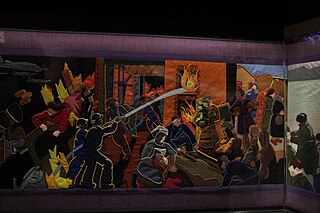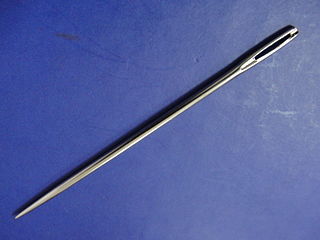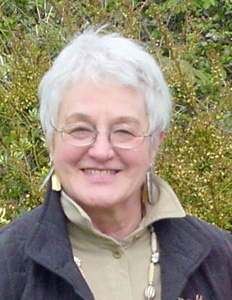
Harold Godwinson, also called Harold II, was the last crowned Anglo-Saxon English king. Harold reigned from 6 January 1066 until his death at the Battle of Hastings on 14 October 1066. It was the decisive battle of the Norman Conquest. Harold's death marked the end of Anglo-Saxon rule over England. He was succeeded by William the Conqueror.

The Bayeux Tapestry is an embroidered cloth nearly 70 metres long and 50 centimetres tall that depicts the events leading up to the Norman Conquest of England in 1066, led by William, Duke of Normandy challenging Harold II, King of England, and culminating in the Battle of Hastings. It is thought to date to the 11th century, within a few years of the battle. Now widely accepted to have been made in England perhaps as a gift for William, it tells the story from the point of view of the conquering Normans and for centuries has been preserved in Normandy.

Tapestry is a form of textile art, traditionally woven by hand on a loom. Normally it is used to create images rather than patterns. Tapestry is relatively fragile, and difficult to make, so most historical pieces are intended to hang vertically on a wall, or sometimes horizontally over a piece of furniture such as a table or bed. Some periods made smaller pieces, often long and narrow and used as borders for other textiles. Most weavers use a natural warp thread, such as wool, linen, or cotton. The weft threads are usually wool or cotton but may include silk, gold, silver, or other alternatives.

The Overlord Embroidery, echoing the Bayeux Tapestry created 900 years before to commemorate the reverse invasion of England from Normandy, is a narrative embroidery that depicts the story of the D-Day Landings of 6 June 1944 and the subsequent Battle of Normandy. The story is told across 34 hand stitched panels running in total to 83 metres in length. The embroidery was created between 1968 and 1974, and is now on permanent display at The D-Day Story, Southsea, Portsmouth.

The Quaker Tapestry consists of 77 panels illustrating the history of Quakerism from the 17th century to the present day. The idea of Quaker Anne Wynn-Wilson, the tapestry has a permanent home at the Friends Meeting House at Kendal, Cumbria, England.

Crewel embroidery, or crewelwork, is a type of surface embroidery using wool. A wide variety of different embroidery stitches are used to follow a design outline applied to the fabric. The technique is at least a thousand years old.
Needlepoint is a type of canvas work, a form of embroidery in which yarn is stitched through a stiff open weave canvas. Traditionally needlepoint designs completely cover the canvas. Although needlepoint may be worked in a variety of stitches, many needlepoint designs use only a simple tent stitch and rely upon color changes in the yarn to construct the pattern. Needlepoint is the oldest form of canvas work.

A sewing needle, used for hand-sewing, is a long slender tool with a pointed tip at one end and a hole to hold the sewing thread. The earliest needles were made of bone or wood; modern needles are manufactured from high carbon steel wire and are nickel- or 18K gold-plated for corrosion resistance. High-quality embroidery needles are plated with two-thirds platinum and one-third titanium alloy. Traditionally, needles have been kept in needle books or needlecases which have become objects of adornment. Sewing needles may also be kept in an étui, a small box that held needles and other items such as scissors, pencils and tweezers.

Reading Museum is a museum of the history of the town of Reading, in the English county of Berkshire, and the surrounding area. It is accommodated within Reading Town Hall, and contains galleries describing the history of Reading and its related industries, a gallery of artefacts discovered during the excavations of Calleva Atrebatum, a copy of the Bayeux Tapestry, finds relating to Reading Abbey and an art collection.
The New World Tapestry was for a time the largest stitched embroidery in the world. It depicts English colonisation in North America, Guyanas, and Bermuda between the years 1583 and 1642, when the English Civil War began.

English embroidery includes embroidery worked in England or by English people abroad from Anglo-Saxon times to the present day. The oldest surviving English embroideries include items from the early 10th century preserved in Durham Cathedral and the 11th century Bayeux Tapestry, if it was worked in England. The professional workshops of Medieval England created rich embroidery in metal thread and silk for ecclesiastical and secular uses. This style was called Opus Anglicanum or "English work", and was famous throughout Europe.

The Battle of Prestonpans Tapestry 1745, or simply the Prestonpans Tapestry, is a large embroidery created in 2010 in Prestonpans, East Lothian, Scotland. It depicts the events before, during and after the Battle of Prestonpans on 21 September 1745, when Bonnie Prince Charlie's Jacobite forces triumphed over the Hanoverian Army led by Sir John Cope. The design, size and style were inspired by the Bayeux Tapestry.

The Bayeux Tapestry tituli are Medieval Latin captions that are embroidered on the Bayeux Tapestry and describe scenes portrayed on the tapestry. These depict events leading up to the Norman conquest of England concerning William, Duke of Normandy, and Harold, Earl of Wessex, later King of England, and culminating in the Battle of Hastings.

The Great Tapestry of Scotland is one of the world's largest community arts projects, hand stitched by 1,000 people from across Scotland. It is made up of 160 linen panels and 300 miles of wool – enough to stretch the entire length of Scotland. It is now on permanent display in its own purpose-built gallery and visitor centre in the town of Galashiels in the heartland of the Scottish Borders.

Magna Carta (An Embroidery) is a 2015 work by English installation artist Cornelia Parker. The artwork is an embroidered representation of the complete text and images of an online encyclopedia article for Magna Carta, as it appeared in English Wikipedia on 15 June 2014, the 799th anniversary of the document.

The Scottish Diaspora Tapestry is a large embroidery, 153 metres (502 ft) in length, crafted from 305 panels that were embroidered in 34 countries. It was the second major tapestry project to have originated from the Prestoungrange Arts Festival in Prestonpans, East Lothian, Scotland. Work on the panels began in 2012. A version of the tapestry was exhibited across Scotland in 2014 for the Homecoming. The tapestry was displayed in locations around Western Europe the following year. November 2015 was the first time that all 305 panels were shown together. In 2016 and 2017 the tapestry toured across Australia and Canada and returned to Edinburgh to go on display in May 2017.

The Game of Thrones Tapestry is a hand-crafted tapestry, woven by hand on a jacquard loom, with additional embroidery. The tapestry tells the entire story of the television show, Game of Thrones. It consists of seven 11-metre-long panels and one 10.5-metre panel. The eight panels depict scenes from each episode and include images of crew at work. The tapestry was commissioned by HBO and Tourism Ireland, the tourism bureau of Northern Ireland where HBO filmed much of the series.
Elizabeth Wardle (1834–1902) was an English embroiderer. In 1857 she married the silk dyer Thomas Wardle, a distant cousin. Thomas was later knighted for his services to the silk industry.

Audrey Walker was an accomplished textile artist, embroiderer and teacher, who was active from the 1970s and 1990s in United Kingdom. Walker became known for developing an innovative style of embroidery based on fine threads applied by machine and by hand, to create striking figurative wall-hung works of art. Walker described her work as evolving from fairly fluid ideas, and the process as being akin to drawing with fabrics.
Leek Embroidery Society was established in 1879 in Leek, Staffordshire. It was known for producing both domestic and ecclesiastical embroidery work, which was granted prestigious awards for its fineness and high quality. The Society also developed a form of embroidery using tussar silk and aimed to promote art embroidery and fine needlework which would be shown in many international exhibitions. The establishment of the Leek Embroidery Society also led to the founding of the Leek School of Art Embroidery.



















